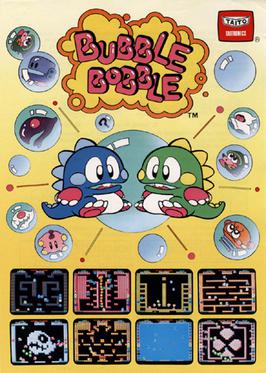
Bubble Bobble is a 1986 platform game developed and published by Taito for arcades. It was distributed in the United States by Romstar, and in Europe by Electrocoin. Players control Bub and Bob, two dragons that set out to save their girlfriends from a world known as the Cave of Monsters. In each level, Bub and Bob must defeat each enemy present by trapping them in bubbles and popping, who turn into bonus items when they hit the ground. There are 100 levels total, each becoming progressively more difficult.
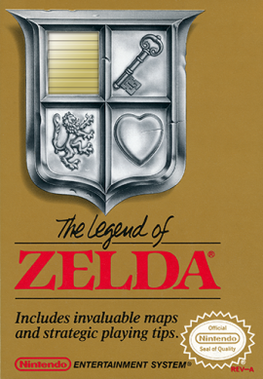
The Legend of Zelda, originally released in Japan as The Hyrule Fantasy: Zelda no Densetsu, is an action-adventure game developed and published by Nintendo. The first game of The Legend of Zelda series, it is set in the fantasy land of Hyrule and centers on an elf-like boy named Link, who aims to collect the eight fragments of the Triforce of Wisdom in order to rescue Princess Zelda from Ganon. The player controls Link from a top-down perspective and navigates throughout the overworld and dungeons, collecting weapons, defeating enemies and uncovering secrets along the way.

In video games, a boss is a significant computer-controlled opponent. A fight with a boss character is commonly referred to as a boss battle or boss fight. Bosses are generally far stronger than other opponents the player has faced up to that point. Boss battles are generally seen at climax points of particular sections of games, such as at the end of a level or stage or guarding a specific objective. A miniboss is a boss weaker or less significant than the main boss in the same area or level, though usually more powerful than the standard opponents and often fought alongside them. A superboss is generally much more powerful than the bosses encountered as part of the main game's plot and is often an optional encounter. A final boss is often the main antagonist of a game's story and the defeat of that character usually provides a positive conclusion to the game. A boss rush is a stage where the player faces multiple previous bosses again in succession.

Ice Climber is a platform game developed and published by Nintendo. It was released in 1985 for both the arcade VS. System and the Famicom / Nintendo Entertainment System console. The characters Popo and Nana, collectively known as the Ice Climbers, scale 32 vertically scrolling, ice-covered mountains to recover stolen vegetables from a giant condor. In some European countries, Ice Climber was bundled with the Nintendo Entertainment System.
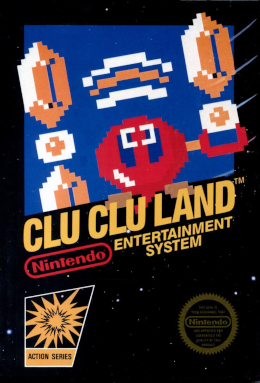
Clu Clu Land is a puzzle video game developed and published by Nintendo in 1984 in Japan for the Famicom. It was released in North America in 1985 as a Nintendo Entertainment System launch game and in Europe in 1987. Nintendo has rereleased it many times via emulation.

Mach Rider is a vehicular combat racing video game developed by HAL Laboratory and published by Nintendo. It was first released for the Famicom console and Nintendo VS. System arcade board in Japan in 1985, then in North America for the VS. System in 1985 and Nintendo Entertainment System in 1986, and then for the PAL region in 1987. It was released on the Virtual Console for the Wii (2007), Nintendo 3DS (2013), and Wii U (2014).

Nekketsu Kōha Kunio-kun, released as Renegade in the West, is a beat 'em up video game developed by Technōs Japan and distributed by Taito for the arcades in 1986. In the original Japanese version Nekketsu Kōha Kunio-kun, the game revolves around a high-school delinquent named Kunio-kun who must stand up against a series of rival gangs frequently targeting his classmate Hiroshi. In the Western version Renegade, the player controls a street brawler who must face four different gangs in order to rescue his girlfriend being held captive by a mob boss.
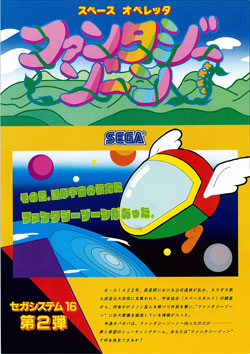
Fantasy Zone is a 1986 arcade video game by Sega, and the first game in the Fantasy Zone series. It was later ported to a wide variety of consoles, including the Master System. The player controls a sentient spaceship named Opa-Opa who fights an enemy invasion in the titular group of planets. The game contains a number of features atypical of the traditional scrolling shooter. The main character, Opa-Opa, is sometimes referred to as Sega's first mascot character.

Breath of Fire is a role-playing video game developed by Capcom originally for the Super Nintendo Entertainment System. Initially released in Japan in April 1993, the game was later made available in North America in August 1994 by Square Soft, who handled the title's English localization and promotion. It is the first entry in the Breath of Fire series.
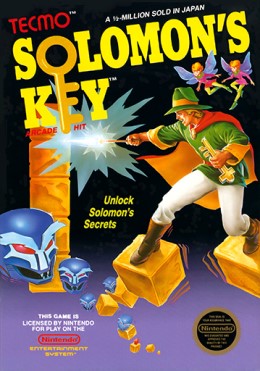
Solomon's Key is a puzzle game developed by Tecmo in 1986 for an arcade release on custom hardware based on the Z80 chipset. It was ported to multiple systems including the Nintendo Entertainment System and Commodore 64. The PC Engine version was known as Zipang and the Game Boy version as Solomon's Club. A prequel, Solomon's Key 2, was released in 1992 for the NES. The game was also ported to Virtual Console for the Nintendo 3DS and Wii U in 2006 and later to Nintendo Switch Online in 2018.
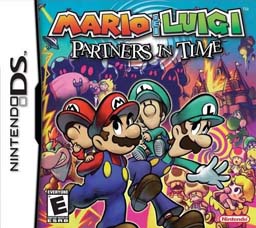
Mario & Luigi: Partners in Time is a role-playing video game developed by AlphaDream and published by Nintendo for the Nintendo DS handheld game console in late 2005. It is the second game in the Mario & Luigi series, and is the prequel/sequel to the 2003 Game Boy Advance game Mario & Luigi: Superstar Saga. The game was later re-released for the Wii U as a Virtual Console title in 2015, available for purchase from the Nintendo eShop.

Spyro 2: Season of Flame is a 2002 platform game developed by Digital Eclipse and published by Universal Interactive for the Game Boy Advance.

Superman is a 1987 NES video game by Kemco based on the DC Comics character. The Japanese release featured a synthesized version of the 1978 film's score, but in the US version, it was replaced by music from another Kemco title, Indora no Hikari, a fantasy-RPG released the same year for the Famicom.

Legendary Wings is a fantasy-themed shoot-'em-up / platformer arcade video game released by Capcom in 1986. The player takes control of a young soldier equipped with magical wings who must save the world from a malfunctioning supercomputer. A home version for the Nintendo Entertainment System was released exclusively in North America in 1988. The original coin-op version is included in Capcom Classics Collection for PlayStation 2 and Xbox and in Capcom Classics Collection Remixed for PlayStation Portable.
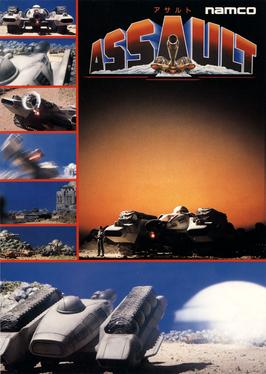
Assault is a 1988 multi-directional shooter arcade game developed and published by Namco. It was licensed to Atari Games for release in North America. Controlling a caterpillar-tread self-propelled gun, the player is tasked with completing each of the game's eleven stages while shooting enemies and avoiding projectiles. It uses a twin-stick control layout, similar to games such as Battlezone. The plot involves the human race searching for new planets after Earth reaches its maximum population - after discovering an exo-planet 35,000 light years away from the Milky Way, they enslave the planet's natives and take control, leading to the planet's native population vowing to abolish the humans and bring peace to their world. The protagonist who rides the aforementioned self-propelled gun which players control, is one such native.

Yokai Dochuki is a 1987 platform arcade game developed and released by Namco in Japan and other parts of Asia. The player controls a young boy named Tarosuke as he must make his way through Jigoku, the Japanese concept of Hell, to reach Buddha, who will determine his fate. Tarosuke can fire small "ki" bullets at enemies to defeat them; he can also charge them to increase their power. Enemies will drop money when defeated, which can be used to purchase weapons and other items in stores. Two versions of the arcade original were released: a Japanese version and an English version which was released in other Asian countries outside Japan. The Arcade Archives release includes both versions.
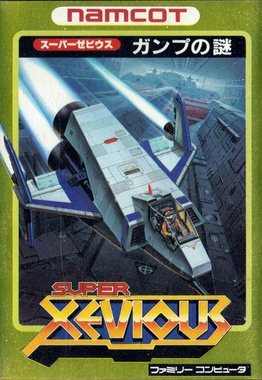
Super Xevious: GAMP no Nazo is a 1986 vertically scrolling shooter video game developed and published by Namco for the Family Computer in Japan. It is the sequel to Xevious, a popular arcade game released in late 1982, and the fourth installment in the Xevious franchise overall. The player controls a spaceship named the Solvalou in its mission to destroy a powerful supercomputer named GAMP, which took over Earth during an ice age. GAMP no Nazo features a heavy focus on puzzle-solving, with each of the game's 21 levels posing a puzzle that must be solved to progress.

Section Z is a horizontally scrolling shooter by Capcom, released as an arcade video game in 1985. A home version was published for the Nintendo Entertainment System in 1987.

Lufia: Curse of the Sinistrals, released as Estpolis: The Lands Cursed by the Gods (エストポリス) in Japan, is an action role-playing game video game co-developed by Neverland and Square Enix for the Nintendo DS. It is a remake of the 1995 Super Nintendo Entertainment System game Lufia II: Rise of the Sinistrals, also developed by Neverland. The character re-designs are by former Square Enix character designer, Yusuke Naora.

Puzzle & Dragons is a puzzle video game with role-playing and strategy elements, developed and published by GungHo Online Entertainment for the iOS, Android, and Amazon Fire platforms.


















